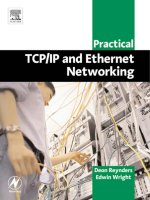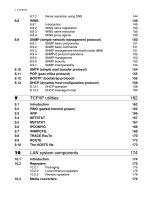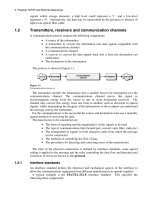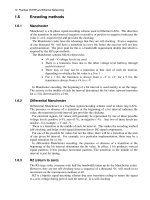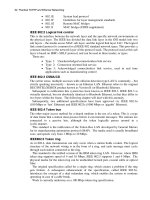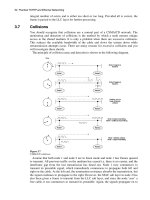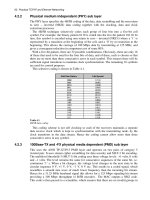Practical TCP/IP and Ethernet Networking- P63 docx
Bạn đang xem bản rút gọn của tài liệu. Xem và tải ngay bản đầy đủ của tài liệu tại đây (22.12 KB, 5 trang )
Index
Acknowledged connectionless service (ALS)
31
Addresses:
address resolution protocol (ARP) 103–4,
106, 163, 166, 171
address reservation cache 104
ARP cache 163, 166
Ethernet interface 103
IP to MAC address 166
IP-to-physical address translation tables
166
physical network cards 166
proxy ARP 106
IP addresses 78–84, 86–9, 102, 104, 106–7,
114, 119, 124, 127, 130, 138, 144–6,
156, 158–9, 162–6, 168–9, 173, 183,
186–7, 195, 201–2, 210, 212, 221, 262
allocation 221
hardware address 80
human ID number 80
social security number 80
Ipv4 address 80, 86, 95
32 bit Ipv4 addresses 86
dotted decimal 80
Ipv6 addresses 79, 94–5, 97–8
anycast 98, 101
multicast 98
unicast 98–9
IPX addresses 98
link-local unicast addresses 100
loopback addresses 100
MAC address 99, 103–7, 159, 161, 163,
166, 183, 185–6, 221
multicast addresses 101
network layer address 187
Novell IPX address 187
NSAP addresses 98
site-local unicast addresses 100
Algorithms 115
America’s Carriers Telecommunications
Association (ACTA) 205
Amplitude 4–5
Analog:
communication channel see
Communication channel
signal 4, 6
Application layer 25–6, 29–30, 133, 221
application service elements (ASEs) 25
data structures 237
Application programming interfaces (APIs)
122
ARPA 75, 191
ASCII 3, 26, 134
Asynchronous 3, 9, 10, 14, 31
asynchronous transfer mode (ATM) 76, 94,
237
file transmission 3
transmission 9–10
bit rate 10
eight-bit serial transmission 10
message frame 10
synchronizing pattern 10
Attenuation 4–5
signal attenuation 4–5
distortion 5
frequency 5
rise-times of the attenuated signals 5
to restore the signal 5
Autonomous systems (Ass) 116–7, 120–1
ISP network 116
multi-homed non-transit AS 116
routing algorithm 116
TCP/IP-based 116
transit AS 116
Binary:
data 1
digits or bits 1
signal 7
Bolt, Barenek and Newman (BBN) 74, 191
Bootstrap protocol (BOOTP) 156–8, 160
bootstrap ROM 156
message format 156–8, 160
RARP 156
server 156
Bridges 177–8, 182, 186, 251
data link protocol 177, 186
intelligent bridges 177
redundant bridges 178
spanning-tree 177–8
transparent bridges 177
local vs bridges 178
Ethernet bridge 178
multi-port bridges 178,182
MAC or LLC bridges 177
source-routing bridges 178
294 Index
SRT and translational bridges 178
source-routing transparent 178
Cable:
AUI cable 45, 48
bus cable 35
CAT5 cable 13
category 4 cable 48
coaxial cable 44–5, 48, 60
fiber optic cable 2, 44, 60, 71, 256
differential mode delay (DMD) 71
light emitting diode 72
multimode fiber 71
network cable 51
point-to-point cable 73
routing cables 116
shielded twisted pair (STP) 60
Thicknet cable 46
twisted pair cable 44
unshielded twisted pair (UTP) 48–9, 60,
63, 65–6, 181
Common gateway interface (CGI) 196–7
CGI program 197
Communication channel 2, 5, 7– 8, 21
analog communications channel 4
channel bandwidth 6
3dB bandwidth 6
maximum data transfer rate 7
mid-band frequencies 6
data channel 10
digital channel 9
practical channel 7
properties 4
PSTN channel 7
types 4
Computer:
computer emergency response team
(CERT) 222, 227
computer operations, audit and security
technology (COAST) 233
Computer Security Institute (CSI) 218,
227, 233
Connector:
25-pin D-connector 45
9-pin D-subminiature connector 69
BNC T-piece connector 47
DIX connector 45
make-break connector 47
N-connector 45
RJ45 connectors 63
SC fiber connectors 69
Co-ordinated universal time (UCT) 113
principle of collision 52
CSMA/CA 76
CSMA/CD 40, 44, 60–1, 76, 183, 251
cable television (CATV) type 44
Cyclic redundancy check (CRC) 14, 51, 53,
54, 250
32-bit generator 14
synchronous data frame 14
transmission interface 14
Data Highway Plus 3
Data:
communication 1, 3, 9, 20–1
asynchronous transmission see
Asynchronous
bit time 9
clock signal 9
direction of signal flow 8
full-duplex see Full-duplex
half-duplex see Half-duplex
simplex see Simplex
synchronization of digital data signals 9
synchronous transmission see
Synchronous
transmission modes 8
data link layer 27–9, 32, 61
data link level 27
Defense Advanced Research Projects Agency
(DARPA) 192
Department of Defense (DOD) model 74–5,
78, 186, 191
Digital:
repeaters or regenerators 7
signal 6
transmission channel 7
Domain name system (DNS) 144, 146–8
country code top-level domains (CCTLDs)
145
DNS clients and servers 146
primary nameserver 146
replicate portions 146
secondary nameserver 146
DNS frame format 147–8
Internet naming scheme 144
fully qualified domain name (FQDN)
145
global domain 145
local domain 145
Index 295
network information center (NIC) 144,
168, 186
name resolution using DNS 144
standard domain names 145
EDU domain 145
registrar web sites 145
top-level domains 145
Dynamic host configuration protocol (DHCP)
78, 158–60, 169, 201–2
DHCP-enabled 158
DHCP server 158–60, 169, 201–2
message format 160–1
operation 158
IP lease request 158
lease release 160
lease renewal 159
Electrical:
energy 5
signal 3, 5, 28, 175
Electromagnetic:
energy 2, 4
induction 14
radiation 14
Encoding:
4B/5B technique codes 13
bi-phase signal-encoding 12
five-bit code 13
Manchester encoding see Manchester
methods 12
NRZ see Non-return to zero
RZ see Return to zero
three-level encoding scheme 13
Error detection 14, 26, 30
asynchronous systems 14
cyclic redundancy check see Cyclic
redundancy check
electromagnetic induction see
Electromagnetic
electromagnetic radiation see
Electromagnetic
error correction 26
longitudinal redundancy check see
Longitudinal redundancy check
noise see Noise
Ethernet 13, 32, 40, 43–5, 49, 58–9, 67, 76,
92–3, 103, 163, 168–9, 174, 177–9, 181–3,
185, 189, 202, 234–5, 238–9, 241, 251
10base2 47, 56–7
disadvantages 47
fly leads 47
physical layout 47
RG-58 A/U or C/U 47
Thinnet 47, 56
10base5 Ethernet 46
Thicknet 56
10baseF 49
fiber backbone 49
10baseT 46–9, 175–6, 178, 184
advantages 48
AWG24 48
disadvantages 48
far end crosstalk (FEXT) 48
standard 48–9
100base-T2 61, 64, 67, 70
features of 100base-T2 64
five-level coding (PAM-5) 64
100base-T4 63
100base-T 60–1, 63–5
adapter cards 65
digital signal processing (DSP) 61, 64,
70
FDDI PMD layer 61
latter cards 65
1000base-CX, for copper cabling 69
1000base-LX, for vertical backbone cabling
69
1000base-LX LICs 69
1000base-SX, for horizontal fiber 69
1000base-SX NICs 69
1000baseT, for category 5 UTP 70
AUI 45
cabling limitations 60
10base-T Ethernet standard 60
coaxial tree 45
collisions see Collisions
design rules 55
cable segments 56
maximum network size 57
maximum transceiver cable length 56
maximum transmission path 57
detection of collisions 43
Ethernet Blue Book 44
Ethernet LAN 32
fast Ethernet design 65
fiber optic cable distances 65
multimode cable 65
node to hub 65
gigabit Ethernet 59, 67–70
frame check sequence (FCS) 71
296 Index
full-duplex repeaters 70
gigabit media independent interface
(GMII) 67
half-duplex gigabit repeaters 71
MAC function 71
medium access control 50–1
carrier sense 51
idle state 50
transceiver 50–1, 56–7
transmit mode 51
medium attachment unit (MAU) 45–8
physical media dependent (PMD) 60–3, 69
ANSI TP-3T9.5 PMD layer 62
eight binary six ternary (8B/6T) 63
hub-to-hub 64
interoperable 64
multilevel threshold-3 (MLT-3) 62–3
noise tolerance 63
physical medium independent (PHY) 62,
67
8B/10B coding 69
8B/10B technique 69
clock synchronization 62
non return to zero – inverted (NRZI) 62–
3, 69
self clocking 62
reducing collisions 55
suggestions 55
signaling methods 50
data stream 50
Ethernet signals 50
Manchester encoding scheme 50
single pair Ethernet 176
sites 43
SQE signal 46–7
station 43
Thick Ethernet (10 Base 5) 18
thinwire Ethernet 47
vampire 45
Extended binary coded decimal interchange
code (EBCIDIC) 3, 26
Extended system configuration data (ESCD)
246
Extensible markup language (XML) 196–7
SGML 196
Federal communications commission (FCC)
205
Fiber optic 57, 176
fiber distributed data interface (FDDI) 76
fiber optic inter repeater link (FOIRL) 49,
57, 176
fiber-optic link 176
Fieldbus 3, 20, 29, 234–5, 238
see also Protocol
Foundation Fieldbus 3
standard 29
File transfer protocol (FTP) 77, 134, 136–7,
246, 268
anonymous FTP 137
GUI-based FTP client 137
internal FTP commands 134
access control commands 134, 135
parameter commands 134
service commands 134
transfer parameter commands 135
TCP command port (21) 137
trivial file transfer protocol (TFTP) 77,
137–9
TFTP transfer identifiers (TIDs) 137
user commands 136
Firewalls 220–2, 225, 233, 236
application layer firewalls 222
dedicated firewalls 220
de-militarized zones (DMZs) 221–2
drawbacks 223
hardware-based firewalls 220
outward-bound packet 221
packet filtering 221
proxy server 222–3, 233, 236
software-based firewalls 220–1
spoofing 221
stateful inspection firewalls 223
Frame transmission 51
collision detection 51, 53
frame reception 51
MAC frame 51
interframe gap 51–2
worst-case time delay 51
Full-duplex 9, 65, 69–72, 126, 176, 178, 183,
207
Gateway 18, 107, 172–3, 187–8, 191, 237
gateway techniques 235
IBM SNA network 187
internetworking devices 187
Greenwich Mean Time (GMT) 113
Half-duplex 8, 29, 63, 71–2
HART 3, 30
Index 297
High level data link control (HDLC) 3
Hub 36, 38, 61, 64–5, 179, 182
10base T hub 175, 180
media independent interface (MII) 64
repeaters see Repeaters
T4 ports 64
TX ports 64
100base-T hubs 64
central hub 38
chassis hubs 181
desktop vs stackable hubs 179
stackable hubs 179, 181
dual-speed hubs 181
dual-speed shared hubs 175
fast Ethernet hubs 181
hub topology 38
interconnection 181
BNC T-piece 181
daisy-chaining 181
non-stackable hubs 181
UTP patch cord 181
modular hubs 181
non-segmentable hub 180
passive hubs 39
segmentable hubs 180
shared vs switched hubs 180
hub share 180
logical hub bus 180
workgroup hubs 180
UTP hub 65
wiring hubs 49
Hypertext markup language (HTML) 194–7
IEEE 28, 31–3, 43–4, 57, 60–1, 240–1, 243
802.1 high level interface 31
802.3 CSMA/CD 32, 43
802.4 token bus 32
802.5 token ring 32
802.6 metropolitan area networks 33
802.7 broadband LANs technical advisory
group (TAG) 33
802.8 fiber optic LANs TAG 33
802.9 integrated voice and data LANs 33
802.10 secure LANs 33
secure data exchange 33
802.11 wireless LANs 33
802.12 fast LANs 33
standards 31
Interface standards 2–3
components 2
EIA/TIA-232-E interface standard 2
interchange circuits, functional description
3
mechanical characteristics 3
International Standards Organization (ISO)
21, 75
Internet layer protocols 78
anycasting 94
authentication headers 97
border gateway protocol (BGP) 117, 120–1
BGP routers 120–1
external BGP (eBGP) 120
internal BGP (iBGP) 120
non-BGP routers 121
routing information 120
synchronization 121
classless inter-domain routing (CIDR) 87–
9, 99, 118, 119
data per fragment 93
fragment offset 92–3
maximum transmission unit (MTU) 93,
119
more fragments (MF) 92
network information center (NIC) 87
protocol analyzers 93
client-server protocol 114
direct vs indirect delivery 114
destination host 114
NetID portions 114
source host 114
exterior gateway protocols (EGPs) 120
fragment headers 97
gateway to gateway protocols (GGP) 117,
120
header format simplification 95
hope-by-hope options header 97
host ID 80, 82–7, 99
interior, exterior and gateway to gateway
protocols 116–7
IGPs and EGPs 117, 120
routing algorithms 117
interior gateway protocols 116–7, 120
international postal system 81
Internet assigned numbers authority (IANA)
79, 86, 94, 99, 144–5
regional Internet registries (RIRs) 79
Internet control message protocol (ICMP)
107–9, 111–2, 164–5, 267
applications 108
error message 109
